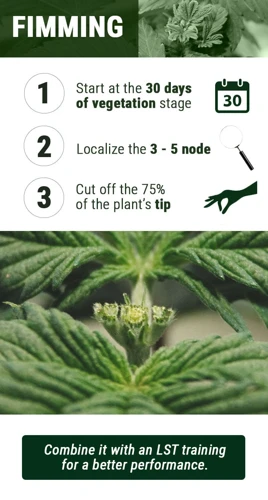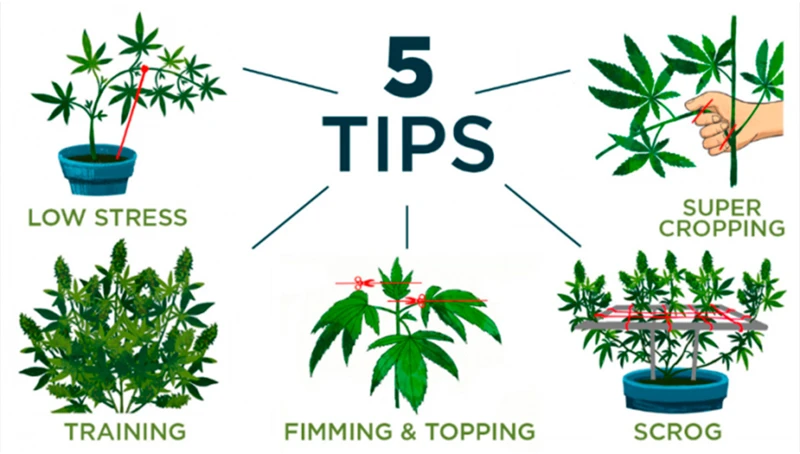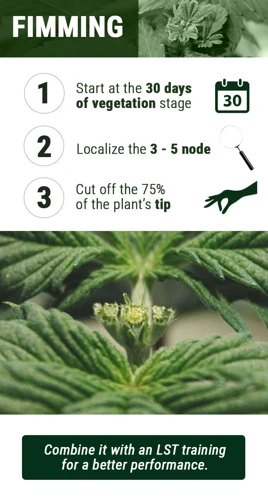
Fimming outdoor vs indoor cannabis plants: How to adjust your technique
Cannabis cultivation is a delicate process that requires careful attention to detail. One of the most important techniques that any grower can utilize is Fimming, but with different growing conditions, one may need to adjust their Fimming techniques. Whether you’re growing indoors or outdoors, Fimming can help you achieve a healthier, more productive plant. In this article, we’ll explore the benefits of Fimming cannabis plants, the differences between Fimming indoors and outdoors, a step-by-step guide on how to Fim your plants, and when the best time is to Fim them. This comprehensive guide will give you the knowledge you need to achieve the best possible results from your Fimming techniques.
What is Fimming?
Contents
Have you ever heard of the term “Fimming” when it comes to growing cannabis plants? If not, don’t worry, you’re not alone. Fimming is one of the many techniques that cultivators utilize to increase their yield and potency of their cannabis plants. This process involves the strategic pruning of the plant to encourage new growth and more bud sites. Let’s explore the intricacies of Fimming and why growers swear by it for achieving better crops.
Fimming Explained
Fimming is a type of pruning technique that is used by cannabis growers to increase the yield of their plants. This technique involves trimming the main stem of the plant in a specific way, which results in a bushier plant with more colas.
What does “Fimming” mean?
Fimming is short for “FIM,” which stands for “F**k, I Missed!” This technique was accidentally discovered by a cannabis grower who was trying to top their plant, but missed and ended up trimming only a portion of the main stem. The resulting plant had more branches and colas, leading to higher yields.
How is Fimming Different from Topping?
Fimming is often confused with topping, which involves cutting the main stem completely. However, Fimming only removes about 75% of the new growth, leaving behind a small cluster of new leaves. This encourages the plant to develop more branches and colas.
What are the Benefits of Fimming?
There are several benefits to using the Fimming technique on cannabis plants. Here are some of the most notable:
| Advantages of Fimming | Explanation |
|---|---|
| Increased Yield | By promoting more branch growth and colas, Fimming can lead to a higher overall yield of buds. |
| Reduced Height | Fimming can also help keep indoor plants at a manageable height, as it encourages bushier growth rather than vertical stretch. |
| Improved Light Distribution | A bushier plant with more colas allows for better light penetration and coverage, leading to more even growth and higher yields. |
| Greater Control Over Plant Shape | Using the Fimming technique can help growers shape their plants in a way that suits their needs, whether that means maximizing space in an indoor grow room or fitting plants into a specific outdoor location. |
Benefits of Fimming
Fimming, a technique used in cannabis cultivation, has become increasingly popular due to its numerous benefits that can increase yield and improve plant growth. Here are some of the key benefits of Fimming:
| Benefit | Description |
|---|---|
| Increased Yield | Fimming causes the plant to grow more lateral branches, resulting in a bushier plant with more buds. This can significantly increase yield, making it a popular technique among growers. |
| Improved Plant Growth | Fimming also results in the growth of more bud sites, which can lead to better overall plant growth. Because the plant’s energy is spread out more evenly, it can result in a healthier plant overall. |
| More Efficient Use of Space | Because Fimming creates a bushier plant, it can lead to a more efficient use of space. Growers can fit more plants into a limited space, leading to an increase in yield overall. |
| Increased Light Exposure | Fimming can also increase the amount of light exposure for the plant’s lower nodes, which can lead to more growth and bud development in these areas. This can again result in a higher yield. |
| Uniform Plant Height | When Fimming is done correctly, it can lead to a more uniform plant height. This can result in a more aesthetically pleasing garden, and can also make harvest easier overall. |
Fimming can be a helpful technique for growers looking to increase their yield and improve plant health. However, it’s important to follow the proper steps and timing to ensure success.
Indoor vs Outdoor
For cannabis growers, the decision to cultivate indoors or outdoors can greatly impact the success of their plants, especially when it comes to pruning techniques like fimming. Both indoor and outdoor growing environments have their distinct advantages and disadvantages, and knowing how to adjust your fimming technique accordingly is crucial. Let’s take a closer look at the differences between indoor and outdoor fimming techniques and how to optimize your fimming approach based on the environment.
Indoor Techniques
Indoor cannabis cultivation provides growers greater control over the plant’s environment, which can lead to better growth and bigger yields. When it comes to fimming indoor cannabis plants, growers can take advantage of the controlled environment to adjust their technique for maximum results. Here are some indoor techniques to consider:
| Technique | Description |
|---|---|
| Screen of Green (ScrOG) | The ScrOG method involves using a screen or net to train tall plants horizontally, allowing for an even canopy of buds. Fimming can be used in conjunction with ScrOG to create even more colas. |
| Low-Stress Training (LST) | LST involves bending and tying down branches to encourage lateral growth and create an even canopy, resulting in bigger yields. Fimming can be used to further improve plant shape and maximize light penetration. |
| Supercropping | This technique involves applying pressure to the stems to cause them to bend and become more pliable. Supercropping can be used to create a more open canopy and promote even growth, with fimming used to create additional colas and maximize growth. |
These indoor techniques, when used in conjunction with fimming, allow growers to manipulate their plants for maximum yield and efficiency. However, it is important to take care when implementing these techniques to avoid damaging the plant or stunting growth. As with all cannabis cultivation techniques, practice and experimentation is key to finding the best method for your plant and environment.
Outdoor Techniques
When it comes to Fimming outdoor cannabis plants, there are certain techniques that need to be adjusted in order to ensure the best possible results. Here are some outdoor techniques for Fimming:
1. Timing: It is important to time the Fimming process correctly when dealing with outdoor plants. This is because outdoor plants have a limited growing window due to seasonal changes, so it’s important to make sure you don’t do it too early or too late.
2. Wait for Multiple Nodes: Since outdoor plants have more space to grow, it’s important to wait for multiple nodes to appear before Fimming. This will ensure that the plant is mature enough to handle the stress and will not stunt its growth.
3. Use Sharp Tools: It’s important to use sharp, clean scissors when Fimming outdoor plants in order to prevent any damage or infection. Make sure to sterilize your scissors with alcohol or hydrogen peroxide before and after every use.
4. Leave Extra Growth: When Fimming outdoor plants, it’s important to leave extra growth on the plant as it will continue to grow and fill in the empty space left by the Fimming process.
5. Sun Exposure: With outdoor plants, it’s important to make sure that the plant is adequately exposed to sunlight after Fimming. Since outdoor plants have more space to grow, it’s important to make sure that the plant is not shaded by other plants or structures.
By following these outdoor techniques, you can ensure that your Fimming process is successful and that your outdoor cannabis plants receive the proper care and attention they need to thrive.
How to Fim Cannabis
Now that we’ve explored the benefits and techniques of Fimming cannabis in different environment, it’s time to walk through the steps of the actual Fimming process. Fimming can be a daunting task for growers, but with the right approach and attention to detail, it can lead to a healthier and more productive plant. In this section, we’ll provide a step-by-step guide to Fimming cannabis and some tips to ensure a successful Fimming experience. So, roll up your sleeves and let’s get started!
Step-by-Step Guide to Fimming
To properly fim your cannabis plants, you need to follow a few steps. The process can be delicate, so it’s important to take your time and be careful with your cuts. Here is a step-by-step guide to fimming:
| Step | Description |
|---|---|
| Step 1: | Wait until your plant has at least 3-4 nodes. |
| Step 2: | Identify the node where you want to fim. This should be the most recent node that has grown, towards the top of the plant. |
| Step 3: | Using a sterilized pair of scissors or a razor blade, make a horizontal cut across the top of the node, about 80% of the way through. |
| Step 4: | Wait for new growth to appear from the two new shoots that will form from the site of the cut. |
| Step 5: | Repeat the process on the new growth, if desired. |
It’s important to make sure you sterilize your cutting tool to avoid introducing any bacteria or diseases to your plant. You can use rubbing alcohol or a flame to sterilize the blade.
Note: Fimming can cause stress to the plant, so it’s important to give it time to recover before fimming again or making any other major changes to the plant’s environment.
Tips for Successful Fimming
Successful fimming requires attention to detail and proper technique. Here are some tips to help you achieve the best results:
- Be prepared: Before starting the fimming process, gather all the necessary tools and supplies. You will need sharp and sterile scissors, rubbing alcohol or hydrogen peroxide for cleaning the scissors, and a clean work surface.
- Choose the right time: Fimming should be done during the vegetative stage of growth, and it’s best to wait until the plant has developed at least 3-4 nodes. This will give you a better idea of which branches to cut.
- Aim for precision: When fimming, make sure to cut directly above the leaf node, leaving about 20-25% of the leaf blade in tact. This will ensure that the plant can still photosynthesize and produce energy while it redirects its growth hormones to the lower branches.
- Don’t overdo it: It’s important to only fim once per node to avoid stunting the plant’s growth. If you fim too many times in one spot, the plant may struggle to recover and could become stressed or unhealthy.
- Be patient: Fimming may cause the plant to appear slower to recover at first, but it will soon redirect its growth hormones to the lower branches and begin to produce new growth. Be patient and give the plant time to adjust.
- Monitor for pests and disease: After fimming, make sure to keep an eye out for any signs of pests or disease, as the stress caused by the process can make the plant more vulnerable to these issues. Proper sanitation and pest management techniques can help prevent any problems.
By following these tips, you can increase your chances of successfully fimming your cannabis plants and enjoying the benefits of a bushier, fuller plant.
When to Fim Cannabis
Determining the right time to perform Fimming on cannabis is crucial for achieving the desired results. You want to ensure that you’re not doing it too early, as it can stunt growth, and not too late, where it may cause stress or not be as effective. In this section, we’ll discuss the two stages of growth to consider for Fimming and how to approach them. So, let’s dive in!
Vegetative Stage
During the vegetative stage of cannabis growth, the plant is focused on creating a strong and sturdy structure before shifting focus to flower production. This stage typically lasts 2-8 weeks, depending on the strain and growing conditions.
Timing: It is recommended to fim during the early-mid vegetative stage when the plant has at least four nodes.
Preparation: Before attempting to fim, make sure the plant is healthy and has adequate nutrition. A stressed or sick plant may not respond well to the stress caused by fimming.
Technique: To fim during the vegetative stage, locate the newest growth tip at the top of the plant and use sharp, sterilized scissors to snip off approximately 75% of the tip. This will redirect the plant’s energy to the nodes directly beneath the cut, promoting bushier growth and potentially increasing yield.
Care: After fimming, closely monitor the plant for any signs of stress or damage. Provide extra support if necessary and adjust growing conditions to encourage healthy growth.
Flowering Stage
When it comes to Fimming your cannabis plants during the flowering stage, it’s important to use caution and have a gentle touch. Fimming during flowering can cause stress to the plant, which can result in reduced yields or damage to the buds. However, if done correctly, Fimming during flowering can still provide some benefits to your plants.
Benefits:
- Increased branch development and growth
- Potentially increased yields
Technique:
- Wait until at least day 21 of the flowering stage before attempting to Fim your plants.
- Use sterilized scissors to make the cut as clean as possible.
- Only Fim the topmost leaves to avoid stressing the rest of the plant.
- Do not Fim any branches that are already producing buds.
- Keep a close eye on the plant after Fimming to ensure there is no damage or stress.
Remember, Fimming during the flowering stage is not recommended unless you have experience and feel comfortable doing so. It’s always better to err on the side of caution and only Fim during the vegetative stage for best results.
Conclusion
In conclusion, Fimming is a popular technique used by cannabis growers to increase yields and promote bushier growth. This process involves pinching off the new growth tips of the plant to encourage the growth of lateral branches. While Fimming can be done both indoors and outdoors, the techniques can differ depending on the environment.
Indoors, Fimming can be done earlier in the vegetative stage to allow for more time in the growing cycle for the plant to recover and produce more branches. Meanwhile, outdoors, Fimming can be done later in the vegetative stage or even in the early stages of the flowering period.
When Fimming cannabis plants, it is important to follow a step-by-step guide carefully to ensure the process is done correctly. Successful Fimming can lead to increased yields, but improper technique can hinder the plant’s growth or even cause damage.
Timing is also crucial when Fimming cannabis. It is recommended to Fim during the vegetative stage to allow the plant to recover and reap the benefits of more branching during the flowering stage. Flowering stage Fimming may cause the plant to produce smaller buds or stop growing altogether.
Overall, Fimming is a great technique for cannabis growers looking to maximize their yields and improve the overall shape and look of their plants. With careful attention to timing and technique, Fimming can be a successful way to encourage bushier, healthier plants.
Frequently Asked Questions
What is the difference between Fimming and Topping?
While both techniques involve removing a portion of the cannabis plant, Fimming involves removing only a portion of the new growth tips while Topping involves removing the entire top of the plant.
Will Fimming increase my cannabis yield?
Yes, Fimming can help increase cannabis yield by creating more colas and thus producing more buds.
What tools do I need to Fim my cannabis plant?
All you need is a pair of sharp, clean scissors or pruning shears.
Can Fimming harm my cannabis plant?
Improper Fimming technique, such as removing too much of the plant, can harm or stunt its growth but when done correctly, Fimming should not cause any harm to your cannabis plant.
Can Fimming be done on autoflowering plants?
Yes, Fimming can be done on autoflowering plants although it is recommended to wait until the plant has 5-6 nodes before attempting Fimming.
Should I Fim my cannabis plant more than once?
Fimming can be done multiple times but it is recommended to wait until the plant has recovered from the first Fimming before attempting another.
Will Fimming affect the potency of my cannabis?
No, Fimming should not affect the potency of your cannabis. The main effect will be an increase in yield and potentially more even lighting on the plant.
Can Fimming be done on all cannabis strains?
Yes, Fimming can be done on most cannabis strains but it is always best to research the strain beforehand to ensure that it can handle the technique.
How long does it take for my plant to recover from Fimming?
It typically takes 3-7 days for the plant to recover from Fimming but this can vary depending on various factors such as the strain and growing conditions.
Can I Fim during the flowering stage?
While it is possible to Fim during the flowering stage, it is not recommended as it can stress the plant and potentially harm the final product.





